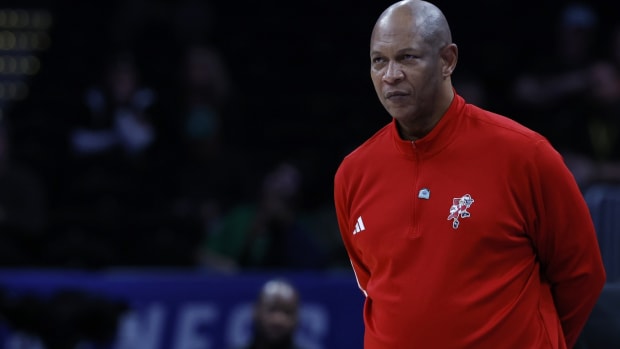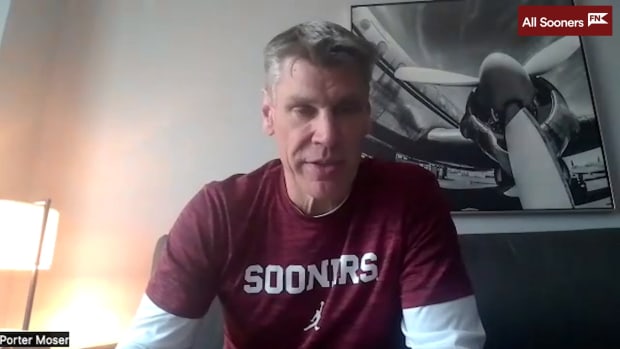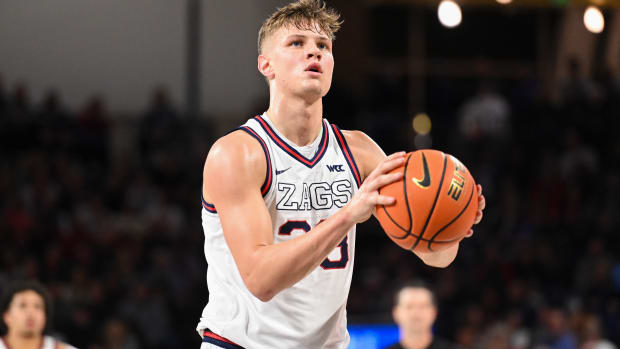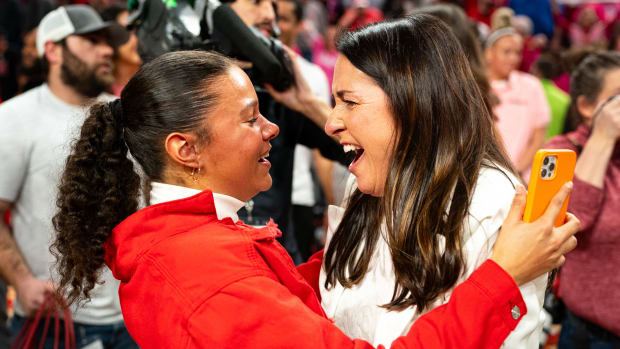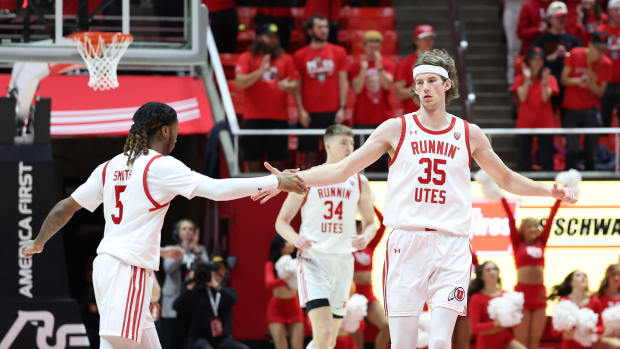Year-End Awards: The Best and Worst of the 2017–18 College Basketball Season
The biggest downside to watching Villanova bask in the afterglow of last Monday’s domination of Michigan in the national championship game was pondering the empty months ahead. The Wildcats, like every other team, won’t play meaningful basketball again until November. Before fretting too much over that long wait, it’s worth reflecting on some of the highlights and lowlights of the 2017–18 season that was—the players, teams, coaches and games that left strong impressions—by handing out awards. While most of these categories are totally made up, some of them will be familiar. All of the honorees are deserving, but we aimed to limit the number of repeat winners.
Player of the Year: Jalen Brunson, Villanova
In the national championship game, Brunson connected on only four of his 13 shot attempts and sat out a large portion of the second half after picking up his fourth foul. That the Wildcats still managed to run Michigan—a team riding a 14-game winning streak and boasting the No. 3 defense in the country, according to Ken Pomeroy’s adjusted efficiency metric—off the floor is a testament to the power of the offense fueled all season long by its junior point guard’s efficient scoring and deft playmaking. Here’s a simple way to sum up his POY candidacy: 2017–18 Villanova will be remembered as one of the best squads since the turn of the century, and Brunson was its best player.
Coach of the Year: Brad Brownell, Clemson
Brownell seemed on shaky ground entering the fall. Clemson had failed to reach the NCAA tournament in six consecutive years, and the buyout on his contract was lowered after the Tigers finished 2016–17 with a 6–12 mark in the ACC and a home loss to Oakland in the first round of the NIT. The Tigers’ decision to bring him back for 2017–18 paid off handsomely.
After being picked to finish 13th in the ACC’s preseason poll, Clemson went on to win 11 games in conference play (fewer than only Virginia and Duke), earned a No. 5 seed in the tourney and reached the Sweet 16 by handling a solid New Mexico State team in the first round and whipping No. 4 seed Auburn in the second. Not even the loss of senior frontcourt cog Donte Grantham to an ACL tear in January could derail Brownell’s remarkable turnaround.
Villanova's Dominance Proves the Power of a Well-Built Program
Biggest Surprise Team: Texas Tech
It didn’t take long for Texas Tech to serve notice that it will be a legitimate force in the Big 12 under head coach Chris Beard. There was serious doubt heading into the season over whether Texas Tech would even make the NCAAs, let alone compete with Kansas at the top of the conference. Not only did the Red Raiders end up notching a double-digit win at Allen Fieldhouse on Jan. 2 and pose a serious threat to the Jayhawks’ league title streak, they earned their highest AP Poll ranking in program history (sixth, in mid-February), secured their highest seed in the tournament (No. 3) since 1996, and made their first trip to the Elite Eight. An ill-timed toe injury to standout senior point guard Keenan Evans prevented Texas Tech from ascending another rung.
Most Disappointing Team: Wichita State
The Shockers entered the season with justifiable national title hype. They were ranked seventh in the AP Poll and eighth in the Coaches Poll, and ESPN’s Basketball Power Index gave them a better chance to cut down the nets than any other Division I team. By March, it was clear those projections were off the mark.
After years of suffocating Missouri Valley Conference opponents with a stingy defense, the Shockers were uncharacteristically porous on that end of the floor in their first season as members of the American Athletic Conference. Wichita State finished sixth in points allowed per possession during AAC play and 111th overall in Pomeroy’s adjusted defensive efficiency. A first-round tourney exit at the hands of No. 13 seed Marshall compounded the disappointment.
Best Tournament Win: No. 16 seed UMBC over No. 1 seed Virginia
The first-ever 16-over-1 shocker did not play out the way most envisioned. There was no buzzer-beating trey, no crunch-time dagger, no overtime Hail Mary. It seemed Penn had a better chance than the three other teams pitted against the bracket’s top seed, but one day after Kansas comfortably beat the Quakers, the Retrievers smoked Virginia, 74–54.
UMBC repeatedly punctured the Cavaliers’ stifling Pack-Line defense, got 28 points from senior guard Jairus Lyles and drained 12 of 24 three-point attempts. All the while, its athletic department Twitter account relentlessly attacked skeptics with biting commentary. This was a seismic victory from an unanticipated source that will go down as one of the biggest upsets in college basketball history.
Game of the Year: Florida 111, Gonzaga 106 (2OT)
This matchup at the PK80 Invitational in Portland didn’t offer the high stakes of March hoops or an optimal tip-off time on the Feast Week calendar. What it did offer is two then top 20 teams waging a double-overtime thriller the night after Thanksgiving that involved 11 ties, 17 lead changes, a 39-point effort from a player on the losing side (Gonzaga’s Johnathan Williams) and a 35-point effort from a player on the winning side (Florida’s Jalen Hudson). Anyone who stayed up into the wee hours for the end of this one saw Bulldogs guard Silas Melson force the second extra session on a driving layup with less than two seconds left overtime No. 1, only to watch as Hudson and Chris Chiozza put the Gators in front for good in double OT with a trio of three-pointers over a 70-second span.
Best Dunk: Northern Colorado’s Jordan Davis vs. Montana, March 9
Davis, a junior guard who spent part of last summer playing for the Azerbaijan national team in the B division of the FIBA U20 European Championship, committed an act of hoops brutality late in the second half of the Big Sky tournament semifinals. After using a screen near the three-point line to knife into the lane, he leapt straight into the chest of Montana senior big man Fabijan Krslovic. They made contact well outside the restricted area, but Davis had more than enough momentum to keep gliding forward, trucking Krslovic in the process, and ram the ball through the rim. Don’t miss the celebration from the Bears’ bench, or the fan shrieking uncontrollably in the background as if a ghost had just hovered down from the rafters at the Reno Events Center.
Cinderella of the Year: Loyola-Chicago
The 11th-seeded Ramblers were a chic pick to win their first-round game over Miami, which they did thanks to a buzzer-beating three from senior wing Donte Ingram. Then they extended their run with more late heroics against No. 3 seed Tennessee in the second round and Nevada in the Sweet 16 before routing Kansas State in the Elite Eight.
The spate of upsets in the South Region opened the door for Loyola, but there’s no denying the simple fact that this was a really good team. The Ramblers won at Florida in early December and lost only three times all season when their leading scorer and assister, redshirt junior guard Clayton Custer, was available. Loyola and its team chaplain Sister Jean Dolores-Schmidt, who attained pseudo-celebrity status and saw her must-have bobblehead go back on sale, earned a prime spot in the glass-slipper pantheon.
Worst Tournament Loss: No. 4 seed Arizona to No. 13 seed Buffalo
There’s no shame in falling to Buffalo, a team that dominated the Mid-American Conference and made half of its 30 attempts from three-point range. By the start of the second weekend, the blowout the Bulls put on the Pac-12 champs had mostly receded into the background of a chaotic tourney, but that doesn’t discount the extent of Arizona’s collapse less than a week after cruising to a conference tournament crown. Sports Illustratedprojected the Wildcats as the nation’s best team last fall because of the roster mix of proven veterans and freshman talent, including a projected top-three pick in this summer’s draft (Deandre Ayton). It was a dispiriting final chapter of a season that fell well short of expectations.
Way-Too-Early Top 25: Ranking the 2018-19 College Basketball Season's Leading Contenders
Shot of the Year: Stanford’s Daejon Davis vs. USC
The Cardinal had no business winning their Jan. 7 home game against USC. Three days after outlasting UCLA by eight points in double overtime, Stanford trailed the Trojans by 15 midway through the second half, at which point its win probability had dipped below 3%, according to ESPN. The Cardinal rallied to tie it at 72 with 2:15 remaining, and Davis put Stanford up two about 30 seconds later with a contested, right-handed layup, but USC pulled back in front with 1.7 seconds left on a reverse layup from point guard Jordan McLaughlin. McLaughlin left too much time for Davis to receive an inbounds pass in space, take one dribble and pull up before the half-court line.
Best Regular-Season Win: Virginia over Duke
This Virginia season will be defined by one improbable postseason loss, but we shouldn’t gloss over everything the Cavaliers accomplished before they fell flat against UMBC. Virginia had rolled through its non-conference schedule and its first eight ACC games without much fuss, but a Jan. 27 trip to Cameron Indoor Stadium figured to offer a good gauge of its standing in the league.
The Cavaliers absorbed a 30-point, 14-rebound double-double from Duke freshman center Marvin Bagley III, held one of the nation’s top offenses below a point per possession and outlasted the Blue Devils for a 65–63 win that pushed Virginia to 20–1 and effectively sealed its third league regular-season championship in five years. It also marked the program’s first victory at Duke since 1995.
Worst Regular-Season Loss: North Carolina against Wofford
By the time North Carolina’s season ended with a humbling 21-point loss to Texas A&M in the second round of the tournament, this late-December stunner had long since faded into the rearview. Wofford traveled to Chapel Hill for a presumed beatdown at the hands of the reigning national champions. North Carolina was unbeaten outside of a neutral-court loss to Michigan State, and there was little reason to suspect the Terriers would even give the Tar Heels a game. Wofford sharpshooter Fletcher Magee apparently thought otherwise. The nation’s leader in three-point field goals this season (148) went off for 27 points in a 79–75 win that represented the program’s first triumph over a Top 25 opponent as well as the season’s second-largest upset at that point, according to ESPN’s Basketball Power Index.
Best Comeback: Nevada vs. Cincinnati
The No. 2 seed Bearcats held a 22-point lead with 11:37 left in the second half against a Nevada team that—working with a six-man rotation and barely two days of rest after an overtime win in Round 1—would have been forgiven for looking up at the scoreboard, coming to terms with Cincy’s penchant for squeezing the life out of opposing offenses and calling it a day. The Wolfpack had other plans. They had enough juice left to rip off a comeback in an eventual 75–73 victory that tied the second-biggest in tournament history, short only of Brigham Young’s 25-point rally against Iona in the 2012 First Four.
Achievement of the Year: Kansas’s streak continues
When evaluating Kansas teams in the Bill Self era, it’s safe to assume that by the end of the regular season, the Jayhawks will take up residence at the top of the Big 12 standings no matter what else happened over the previous nine weeks of conference play. That remains true after Kansas managed to extend its streak of winning at least a share of the league championship to 14 years, eclipsing a record set by UCLA from 1967 to ’79.
The Jayhawks’ latest title was not a foregone conclusion. They lost their top recruit (five-star power forward Billy Preston) to the pros without him playing a minute, dropped three home games in a season for the first time under Self and in February found themselves trailing Texas Tech by a game. Kansas ultimately prevailed after a massive late-February win in Lubbock and proceeded to make the Final Four.
Non-Achievement of the Year: Wisconsin’s NCAA tournament miss
This Badgers team was not a popular pick to compete for a Big Ten title or even extend its run of top-four finishes in the league standings to 17 years. A media poll conducted by The Athletic last October pegged it seventh, and SI’s preseason projection model had it 40th in the nation. But it was still jarring to watch Wisconsin walk off the Madison Square Garden floor after a three-point loss to Michigan State in the Big Ten tournament and come to grips with the fact that the Badgers would not be in the bracket for the first time since 1997–98, four years before Bo Ryan took over. Wisconsin’s run of 19 consecutive tournament bids was tied with Gonzaga for the fourth-longest active streak and included 10 trips to the Sweet 16 and three to the national semifinals.
Best Dribbling Sequence: Middle Tennessee State’s Tyrik Dixon
What began as a guard’s innocent ball advancement escalated into one of this season’s meanest crossovers, non-James Harden division. Middle Tennessee’s Tyrik Dixon slowly approached half court while sizing up his defender, UTEP’s Evan Gilyard. Gilyard would have been better off just getting out of the way. Little did he know he was about to find himself on the wrong end of a savage ankle breaker. As Gilyard prepared to bend down into a defensive stance, Dixon planted his right leg into the hardwood and whipped the ball across his body. Gilyard’s feet got tied up as he leaned to his left, sending him tumbling to the top of the Blue Raiders’ half court logo. His humiliation was only beginning. Instead of scooting away to take advantage of a 5-on-4 situation, Dixon stopped and pointed at Gilyard as the crowd let out a collective “OHHH!!”
Most Polarizing Player: Trae Young, Oklahoma
When Young bloomed into a national superstar by unhesitatingly pulling up for deep, parabolic jumpers, slinging dimes into tight windows and posting absurd box-score lines, there were virtually no dissenting voices. Young’s excellence was self-evident, and he deserved to be lauded as one of the best freshman ever. As Oklahoma repeatedly stumbled in conference play and opponents homed in on shutting down Young, he seemed to wear down under a gargantuan offensive workload on a team with few viable alternative scoring options.
Unrelenting media coverage did him no favors among critics who took issue with his shoot-first-ask-questions-later style, and Young ultimately was overtaken in the race for the NPOY honors that he seemed on the verge of locking up at one point. Whatever his legacy in an Oklahoma uniform, Young was a spellbinding talent whose lone college season won’t soon be forgotten.
Strangest Individual Season: Michael Porter Jr., Missouri
Porter Jr. opened the season as a preseason All-America, possible NPOY threat and projected lottery pick for a Missouri team with a revamped roster, a new head coach and realistic hopes of making noise at the top of the SEC. He ended it with no individual accolades to speak of, a 1–2 team record in games he appeared in and less than an hour of film for NBA front office types to pore over. A back injury sidelined Porter Jr. for most of his freshman campaign, save a two-minute cameo in the Tigers’ Nov. 10 opener against Iowa State, a 23-minute stint in the SEC tournament against Georgia and a 28-minute outing in their first-round tourney loss to No. 9 seed Florida State. Porter Jr. declared for the draft late last month after logging only 53 minutes, 30 points and 20 rebounds in his college career.
Strangest Game: Alabama vs. Minnesota, Nov. 25
This low-key neutral-site matchup at Barclays Center the Saturday after Thanksgiving turned into a mesmerizing battle that stretched the definition of “undermanned” in a basketball context. A brawl resulted in the ejection of Alabama’s whole bench, and the Crimson Tide were reduced to three available players for the final 10 minutes of the second half after one player (sophomore guard Dazon Ingram) fouled out and another (freshman guard John Petty) suffered an ankle injury. Rather than folding in the face of a daunting personnel disadvantage, the Crimson Tide cut into Minnesota’s 11-point lead to make it a one-possession game with under two minutes remaining. Despite getting 40 points on 12-of-22 shooting, six rebounds and five assists from stud freshman point guard Collin Sexton, Alabama ultimately came up short in its valiant comeback attempt, losing 89–84.
Most Deceptive Hot Start: Arizona State
It’s not unusual for teams to amass gaudy win-loss records early in the season while fattening up on overmatched creampuffs in a string of “buy” games. Take Georgetown, which was unbeaten into mid-December after facing only two opponents that finished higher than 300th in Pomeroy’s ratings, and none that finished higher than 185th.
By contrast, when Arizona State moved to 12–0 and rose to No. 3 by Christmas, it had the sort of quality victories (San Diego State, Kansas State, Xavier, Kansas) that supported the notion that the Sun Devils were actually, you know, good. Arizona State’s non-conference record turned out to be grossly misleading. The Sun Devils went on to record an 8–10 mark in the Pac-12 and settle for a spot in the First Four in Dayton, where they fell to Syracuse.
• PHOTOS: The Best Moments of March Madness 2018
Most Deceptive Slow Start: Ohio State
Not much was expected of Ohio State during the first season of the post-Thad Matta era. In the aforementioned Big Ten media poll conducted by The Athletic, Ohio State was voted 11th out of 14 teams. So when the Buckeyes went 5–3 over their first eight games, with losses to Gonzaga, Butler and Clemson, it felt like an appropriately underwhelming start for a program trying to turn the page from an abrupt end to a 13-year coaching reign. Maybe Ohio State just needed the first month of the season to figure things out. Beginning with a 25-point pasting of Wisconsin at the Kohl Center on Dec. 2, the Buckeyes lost two of 19 games. They went on to earn a No. 5 seed in the NCAAs, register top-25 marks in Pomeroy’s adjusted offensive (23rd) and defensive (15th) efficiency and produce both a conference player of the year (redshirt junior forward Keita Bates-Diop) and a national coach of the year candidate (Chris Holtmann).
Best High-Major Conference: Big 12
This version of the Big 12 offered both elite teams and top-to-bottom quality, two hallmarks of conference strength that bore out the league’s reputation as a rigorous crucible with virtually no easy games on the schedule. Seven of the league’s 10 squads earned invitations to the tourney (Kansas, Kansas State, Oklahoma, Texas, TCU, Texas Tech, West Virginia), and two more of them (Baylor, Oklahoma State) were widely considered among the biggest snubs on Selection Sunday.
Among the Big 12 outfits that were placed in the big bracket, three (Kansas, Kansas State, Texas Tech) reached the Elite Eight and one made it to the Final Four (Kansas). Setting aside postseason performance, the Big 12 ranked first in Pomeroy’s adjusted efficiency margin and had only one of its teams (Iowa State) finish outside the top 65 of ESPN’s BPI.
Worst High-Major Conference: Pac-12
Here’s how you know the Pac-12 had a really rough season: It didn’t have any teams left in the NCAAs at the end of the first day of first-round play. Both Arizona State and UCLA came up short in their First Four matchups with Syracuse and St. Bonaventure, respectively, and conference champ Arizona was blown out by Buffalo. The confluence of events that resulted in the Pac 12 producing only one squad with a résumé worthy of avoiding Dayton involves a sprawling federal investigation into corruption across the sport, a shoplifting incident in China that drew in President Trump, missed opportunities in non-conference play and a talent-stuffed preseason title contender’s inability to reach its ceiling. What are the chances that things improve in 2018–19? Our early top 25 includes only two Pac-12 teams (Oregon, at No. 14 and UCLA, at No. 19).
Block of the Year: Sagaba Konate on Mikal Bridges
Bridges, Villanova’s lottery-bound redshirt junior wing, must not have realized what he was signing up for midway through the second half of the Wildcats’ Sweet 16 win over West Virginia when he decided to rumble into the lane on a fast break, rise up and hammer home a one-handed dunk on Konate, the Mountaineers’ sophomore shot-swatting ace.
As Bridges rose and cocked the ball behind his head with his right hand, Konate prepared for takeoff inside the restricted area, sprung off two feet and extended his arms perpendicular to the court. The resulting in-air collision with Bridges—which was described in exquisite fashion by veteran broadcaster Ian Eagle (“Denied! Konate!”)—provided a rare moment in the tourney where something did not go Villanova’s way. It doubled as the capstone of Konate’s catalog of rejections this season, including a strikingly similar two-handed stuff of Kansas’s Marcus Garrett in January.
Freshman of the Year: Deandre Ayton, Arizona
The tidal wave of hype that attended Ayton’s arrival in Tucson last year as one of the top prospects in the class of 2017 was appropriate. Ayton was as good as the lofty recruiting evaluations and top-tier mock-draft placements suggested he would be. The Wildcats’ failure to congeal into the formidable two-way outfit most imagined when looking at their loaded roster before the season shouldn’t detract from what Ayton achieved during his one season in college. While most of the college basketball-consuming public was getting caught up in Trae Young mania, Ayton was regularly terrorizing Pac-12 frontcourts with his interior scoring and voracious glass-cleaning—including when he dropped 28 points on 11-of-15 shooting with 18 rebounds and four blocks at Oregon the day after a report tied him to a six-figure payment to secure his signing with Arizona. Ayton led the Pac-12 in total rebound percentage and finished second in the conference with 20.1 points per game.
Senior of the Year: Jock Landale, Saint Mary’s
Landale was the fulcrum of one of the top offenses outside of the high-major conferences. A year after driving the Gaels to a top-15 rank in Pomeroy’s adjusted efficiency, Landale pulled off the often difficult task of shouldering a heavy offensive burden and upping his scoring efficiency. Compared to his junior season, Landale increased his two-point accuracy over 103 more attempts and shot a higher percentage from the free-throw line. He also led the country in both Player Efficiency Rating and offensive win shares.
West Coast Conference big men had no answers for Landale’s advanced inside scoring arsenal, but it would have been nice to watch him take on a brand-name opponent from a different conference in the NCAAs. Instead, in large part because of the Gaels’ putrid non-conference schedule, the big Aussie had to settle for a trio of NIT games in Moraga against Southeastern Louisiana, Washington and Utah.
Breakout Player of the Year: Carsen Edwards, Purdue
Edwards hinted that a major leap was in store for him with his performance at the FIBA World Cup last summer as a member of USA’s U19 squad, which he led in both assists and minutes per game. He went above and beyond the standard year-to-year improvement sophomores tend to make by blossoming into one of the top scoring guards in the country.
In filling the sizable shot-creation hole left by Big Ten Player of the Year Caleb Swanigan’s departure for the NBA, Edwards boosted both his usage and efficiency while functioning as the engine of the nation’s top offense west of Villanova. Edwards shot the ball more accurately from both sides of the three-point arc, slashed his turnover rate, got to the free-throw line more often and connected on a larger percentage of his attempts once there. Edwards should be on the NPOY short list as a junior if he decides to return to West Lafayette after recently declaring for the draft without hiring an agent.
The Michael Jordan of Anywhere: Donte DiVincenzo Gives Villanova a Huge Spark at Perfect Time
Best NCAA Tournament Performance: Donte DiVincenzo, Villanova
Watching DiVincenzo drain long-range bombs, zoom to the basket for close-range finishes, rise up for a Konate-esque, two-handed denial of Michigan’s Charles Matthews and fire a nifty, two-handed laser to Omari Spellman for an uncontested dunk, there was a feeling of inevitability—a sense that DDV was going to get whatever he wanted, whatever the Wolverines did to try to stop him. Michigan had spent most of the tourney shackling opposing scorers, but it had no effective strategy for containing DiVincenzo in takeover mode. When he scored his first basket of the night, Villanova trailed Michigan 14–8 midway through the first half. DiVincenzo finished 10-of-15 from the field for 31 points, the most in a title game since Arizona’s Miles Simon put up 30 against Kentucky in 1997 and the most ever for a player who came off the bench in a title game.
Best Performance Outside of the NCAA Tournament: Markus Howard vs. Providence
Howard established himself as one of the nation’s premier three-point shooters by sinking 54.7% of his 150 attempts as a freshman last season. The Golden Eagles’ Jan. 3 game at Providence offered a captivating distillation of the potency of his long-range marksmanship. Howard connected on 11 of his 19 tries from beyond the arc, as well as six of his 10 attempts from inside the arc and all seven of his attempts from the free-throw line, to post 52 points in a 95–90 overtime win.
Howard wasn’t taking advantage of a permissive opponent; the Friars ranked second in points allowed per possession during Big East play. His 52 tied former Friars wing Marshon Brooks against Notre Dame in 2011 for the Big East record and topped any output put up by any other player this season. In case you’re wondering, Howard hit 40.4% of his 275 tries from distance this season, and he ranked second among qualified DI players by hitting 93.8% of his 112 free throw attempts.




